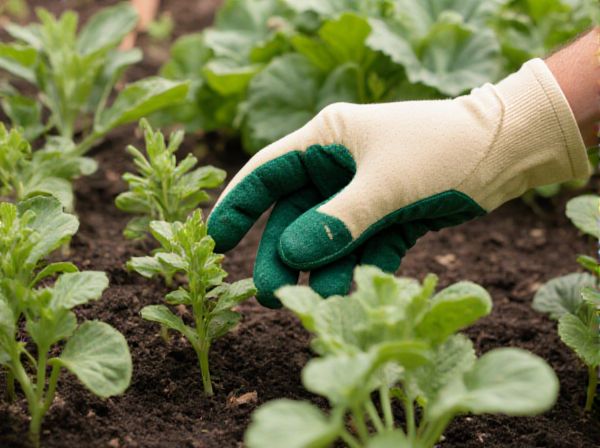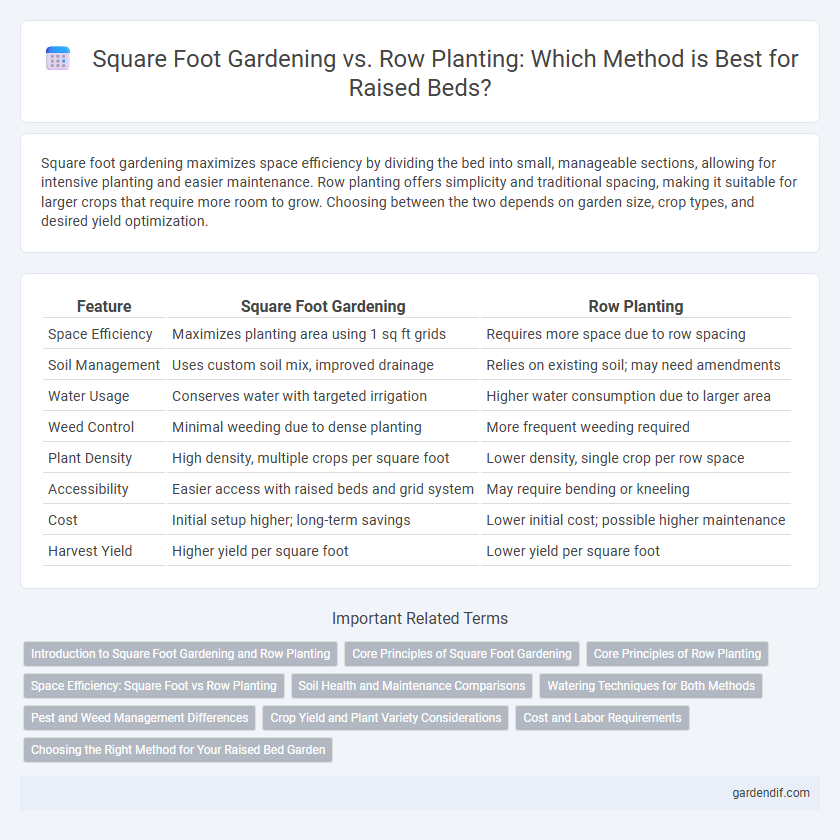
Square Foot Gardening vs Row Planting Illustration
Square foot gardening maximizes space efficiency by dividing the bed into small, manageable sections, allowing for intensive planting and easier maintenance. Row planting offers simplicity and traditional spacing, making it suitable for larger crops that require more room to grow. Choosing between the two depends on garden size, crop types, and desired yield optimization.
Table of Comparison
| Feature | Square Foot Gardening | Row Planting |
|---|---|---|
| Space Efficiency | Maximizes planting area using 1 sq ft grids | Requires more space due to row spacing |
| Soil Management | Uses custom soil mix, improved drainage | Relies on existing soil; may need amendments |
| Water Usage | Conserves water with targeted irrigation | Higher water consumption due to larger area |
| Weed Control | Minimal weeding due to dense planting | More frequent weeding required |
| Plant Density | High density, multiple crops per square foot | Lower density, single crop per row space |
| Accessibility | Easier access with raised beds and grid system | May require bending or kneeling |
| Cost | Initial setup higher; long-term savings | Lower initial cost; possible higher maintenance |
| Harvest Yield | Higher yield per square foot | Lower yield per square foot |
Introduction to Square Foot Gardening and Row Planting
Square Foot Gardening maximizes space by dividing raised beds into one-foot sections, allowing efficient planting of diverse crops in small areas. Row Planting organizes crops in long, straight lines, traditionally suited for larger garden spaces and easier mechanization. Square Foot Gardening enhances yield in compact gardens, while Row Planting supports extensive cultivation and crop rotation.
Core Principles of Square Foot Gardening
Square Foot Gardening maximizes space by dividing raised beds into one-foot sections, allowing precise planting density and optimized nutrient use within each square. Core principles include soil mix layering with a blend of compost, peat moss, and vermiculite to enhance drainage and fertility, leading to healthier plants and higher yields. This method minimizes weed growth and reduces water consumption compared to traditional row planting, increasing overall garden efficiency.
Core Principles of Row Planting
Row planting relies on linear planting arrangements with evenly spaced seeds to optimize sunlight exposure, airflow, and ease of cultivation, promoting healthy plant growth. This method prioritizes accessibility for weeding, watering, and harvesting, making it suitable for larger areas and diverse crop types. The core principle is to maintain organized rows that facilitate efficient pest management and crop rotation while maximizing soil nutrient use.
Space Efficiency: Square Foot vs Row Planting
Square Foot Gardening maximizes space efficiency by dividing the bed into one-foot sections, allowing for denser planting and optimized crop rotation within limited areas. Row planting typically requires wider spacing and aisle access, resulting in less productive use of available garden space. This method increases yield per square foot, making it ideal for small or urban gardens where space is at a premium.
Soil Health and Maintenance Comparisons
Square Foot Gardening enhances soil health by promoting dense planting and minimizing soil disturbance, which preserves microbial activity and structure. Row planting often requires frequent tilling, leading to soil compaction and disruption of beneficial organisms. Raised beds in Square Foot Gardening also improve drainage and nutrient retention, reducing the need for supplemental fertilizers and irrigation maintenance.
Watering Techniques for Both Methods
Square Foot Gardening uses precise watering techniques, often relying on drip irrigation or soaker hoses to deliver water directly to individual plant cells, minimizing waste and promoting deep root growth. Row planting typically involves overhead sprinklers or furrow irrigation, which can result in uneven water distribution and higher evaporation rates. Efficient water management in square foot gardening enhances moisture retention and reduces the frequency of watering compared to traditional row planting methods.
Pest and Weed Management Differences
Square Foot Gardening minimizes pest infestations by promoting dense planting, which creates a natural barrier that deters pests and reduces open soil exposure where weeds thrive. Row Planting often requires more frequent weeding and pest control due to wider spacing and exposed soil, making it easier for weeds to establish and pests to access crops. Effective pest and weed management in Square Foot Gardening relies on intensive planting and organic mulches, while Row Planting depends heavily on manual weeding and chemical interventions.
Crop Yield and Plant Variety Considerations
Square Foot Gardening maximizes crop yield by densely planting a diverse variety of crops within small, organized sections, optimizing space and reducing soil depletion. Row planting, while allowing for larger individual plants and easier mechanization, often results in lower overall productivity per square foot due to wider spacing requirements. For gardeners aiming to cultivate multiple plant varieties with high yields in limited space, Square Foot Gardening offers superior efficiency compared to traditional row planting.
Cost and Labor Requirements
Square Foot Gardening significantly reduces labor and cost compared to traditional row planting by maximizing space efficiency and minimizing soil amendment needs. Raised bed materials for square foot gardens require an initial investment, but ongoing maintenance costs are lower due to less weeding and watering. Row planting demands larger plots, more soil preparation, and frequent maintenance, increasing both labor hours and overall expenses.
Choosing the Right Method for Your Raised Bed Garden
Square Foot Gardening maximizes space by dividing raised beds into small, manageable sections, ideal for intensive planting and efficient crop rotation, while row planting offers straightforward access for larger crops and easier weeding. Raised beds benefit from Square Foot Gardening when growing a variety of vegetables in limited space, optimizing soil nutrients and water use. Selecting the right method depends on your crop diversity, space availability, and maintenance preferences for optimal raised bed productivity.
Square Foot Gardening vs Row Planting Infographic

 gardendif.com
gardendif.com